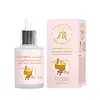What's inside
What's inside
 Key Ingredients
Key Ingredients

 Benefits
Benefits

 Concerns
Concerns

 Ingredients Side-by-side
Ingredients Side-by-side

Oryza Sativa Bran Water
MaskingAvena Sativa Kernel Extract
AbrasiveSqualane
EmollientPropanediol
SolventGlycerin
HumectantDimethyl Sulfone
SolventCaprylic/Capric Triglyceride
MaskingWater
Skin ConditioningButylene Glycol
HumectantAvena Sativa Kernel Oil
Skin ConditioningLinum Usitatissimum Seed Oil
PerfumingCentella Asiatica Extract
CleansingGlycine Max Oil
EmollientPanthenol
Skin ConditioningBetaine
HumectantPolyglyceryl-6 Stearate
EmollientGlyceryl Stearate
EmollientCorylus Avellana Seed Oil
EmollientCetearyl Alcohol
EmollientCeramide Ng
Skin ConditioningHelianthus Annuus Seed Oil
EmollientCamellia Sinensis Leaf Extract
AntimicrobialRosmarinus Officinalis Leaf Extract
AntimicrobialChamomilla Recutita Flower Extract
MaskingArginine
MaskingTocopheryl Acetate
AntioxidantCetyl Palmitate
EmollientSorbitan Palmitate
EmulsifyingCaprylyl Glycol
EmollientScutellaria Baicalensis Root Extract
AstringentGlycyrrhiza Glabra Root Extract
BleachingCaprylhydroxamic Acid
Zanthoxylum Piperitum Fruit Extract
Skin ConditioningPolyglyceryl-6 Behenate
Emulsion StabilisingCarbomer
Emulsion StabilisingPulsatilla Koreana Extract
Skin ConditioningSorbitan Olivate
EmulsifyingXanthan Gum
EmulsifyingUsnea Barbata Extract
Polygonum Cuspidatum Root Extract
AntioxidantMelaleuca Alternifolia Leaf Oil
AntioxidantCitrus Aurantium Bergamia Leaf Oil
AstringentCedrus Atlantica Bark Oil
MaskingOryza Sativa Bran Water, Avena Sativa Kernel Extract, Squalane, Propanediol, Glycerin, Dimethyl Sulfone, Caprylic/Capric Triglyceride, Water, Butylene Glycol, Avena Sativa Kernel Oil, Linum Usitatissimum Seed Oil, Centella Asiatica Extract, Glycine Max Oil, Panthenol, Betaine, Polyglyceryl-6 Stearate, Glyceryl Stearate, Corylus Avellana Seed Oil, Cetearyl Alcohol, Ceramide Ng, Helianthus Annuus Seed Oil, Camellia Sinensis Leaf Extract, Rosmarinus Officinalis Leaf Extract, Chamomilla Recutita Flower Extract, Arginine, Tocopheryl Acetate, Cetyl Palmitate, Sorbitan Palmitate, Caprylyl Glycol, Scutellaria Baicalensis Root Extract, Glycyrrhiza Glabra Root Extract, Caprylhydroxamic Acid, Zanthoxylum Piperitum Fruit Extract, Polyglyceryl-6 Behenate, Carbomer, Pulsatilla Koreana Extract, Sorbitan Olivate, Xanthan Gum, Usnea Barbata Extract, Polygonum Cuspidatum Root Extract, Melaleuca Alternifolia Leaf Oil, Citrus Aurantium Bergamia Leaf Oil, Cedrus Atlantica Bark Oil
Paraffinum Liquidum
EmollientTriisononanoin
Skin ConditioningCetearyl Ethylhexanoate
EmollientIsopropyl Myristate
EmollientRetinyl Palmitate
Skin ConditioningHelianthus Annuus Seed Oil
EmollientTocopheryl Acetate
AntioxidantAnthemis Nobilis Flower Oil
MaskingLavandula Angustifolia Oil
MaskingRosmarinus Officinalis Leaf Oil
MaskingCalendula Officinalis Extract
Skin ConditioningGlycine Soja Oil
EmollientBisabolol
MaskingTocopherol
AntioxidantParfum
MaskingAlpha-Isomethyl Ionone
PerfumingAmyl Cinnamal
PerfumingBenzyl Salicylate
PerfumingCitronellol
PerfumingCoumarin
PerfumingEugenol
PerfumingFarnesol
PerfumingGeraniol
PerfumingHydroxycitronellal
PerfumingLimonene
PerfumingLinalool
PerfumingCI 26100
Cosmetic ColorantParaffinum Liquidum, Triisononanoin, Cetearyl Ethylhexanoate, Isopropyl Myristate, Retinyl Palmitate, Helianthus Annuus Seed Oil, Tocopheryl Acetate, Anthemis Nobilis Flower Oil, Lavandula Angustifolia Oil, Rosmarinus Officinalis Leaf Oil, Calendula Officinalis Extract, Glycine Soja Oil, Bisabolol, Tocopherol, Parfum, Alpha-Isomethyl Ionone, Amyl Cinnamal, Benzyl Salicylate, Citronellol, Coumarin, Eugenol, Farnesol, Geraniol, Hydroxycitronellal, Limonene, Linalool, CI 26100
 Reviews
Reviews

Alternatives
Ingredients Explained
These ingredients are found in both products.
Ingredients higher up in an ingredient list are typically present in a larger amount.
Helianthus Annuus Seed Oil is the oil derived from the seeds of a Sunflower. Sunflower seed oil is non-fragrant. It is an emollient, meaning it helps to soften the skin.
Sunflower seed oil contains many fatty acids. The fatty acids found in sunflower seeds include (from highest amount to least): linoleic acid, myristic acid, palmitic acid, stearic acid, arachidic acid, oleic acid, and linolenic acid.
These fatty acids help the skin create ceramides. Ceramides play a role in repairing the skin barrier.
Helianthus Annuus Seed Oil helps moisturize the skin. This in turn helps the skin look more rejuvenated and smoother.
Sunflowers are rich in vitamin E.
Historians believe Indigenous cultures of North America domesticated sunflowers before corn. Thus they relied on sunflower oil for a variety of uses. One such use is moisturizing skin and hair.
Sunflower seed oil may not be fungal acne safe. We recommend speaking with a professional if you have any concerns.
Learn more about Helianthus Annuus Seed OilTocopheryl Acetate is AKA Vitamin E. It is an antioxidant and protects your skin from free radicals. Free radicals damage the skin by breaking down collagen.
One study found using Tocopheryl Acetate with Vitamin C decreased the number of sunburned cells.
Tocopheryl Acetate is commonly found in both skincare and dietary supplements.
Learn more about Tocopheryl Acetate